 |
 |
 |
| |
Randomized, Placebo-Controlled, Dose-Escalation Trial of New HCV Drug CPG 10101 Toll-Receptor Antagonist in Patients with Chronic Hepatitis C Virus
|
| |
| |
Reported by Jules Levin
EASL, April 2006, Vienna, Austria
Authors: J.G. McHutchison1, B.R. Bacon1, S.C. Gordon1, E. Lawitz1, M. Shiffman1, N.H. Afdhal1, I.M. Jacobson1, A. Muir1
A, Vicari2, S. Efler2, M. Al-Adhami2, M.L. Morris2, H.L. Davis2
1Alliance for Liver Therapy (ALT Group)
2Coley Pharmaceutical Group, Inc.
Study Design
- Multicenter randomized, placebo controlled, dose escalation Phase Ib study
- Conducted at 8 US sites
- 60 subjects: 13 placebo, 47 CPG 10101
- Predominantly Treatment-Refractory patients
- Dosing regimen (subcutaneous injection) over 4 wks
- Cohorts 1-5: twice weekly at 0.25, 1, 4, 10, 20 mg
- Cohorts 6-7: once weekly at 0.5, 0.75 mg/kg
Follow-up to day 50
Author Summary & Conclusions
Stimulates immune system
- Cytokines & chemokines with known antiviral properties
- Activates cells: NK, T, pDC, NKT, B
Decreases in HCV RNA (≥ 1 log)
- All dose groups ≥ 1 mg
- Different patterns of response
- Dose-dependent trend - mean max decrease of 1.69 log10
at 0.75 mg/kg once weekly
Tolerated up to doses of 20 mg 2X/week and 0.75 mg/kg 1X/week
- AEs reflect immunostimulatory activity
Once weekly CPG 10101 dosing sufficient to achieve antiviral effects.
BACKGROUND
CPG 10101 (ACTILON ):
Investigational TLR9 Agonist for Treatment of HCV
CPG 10101 stimulates an immune response as interferon does, as you can see from the text & picture immediately below.
- Synthetic Oligodeoxy-nucleotide (ODN)
- Targeted Mechanism
- TLR9 agonist
- DC-mediated immune stimulation
Immunological Mechanism
- pDC-mediated
- Innate
- Adaptive
Synergistic with IFN-_
(Vollmer, et al. Antiviral Therapy 2002; 7:L115)

CPG 10101 Dose Escalation Study in HCV Patients
Objectives
- Safety & tolerability
- Plasma viral RNA levels
- Pharmacodynamics
- Pharmacokinetics
Study Population & Demographics
There were 6-10 patients in each of the 9 treatment arms. Mean age was about 50 yrs. Mean weight was mostly 85-89 kg with 1 arm 106 kg (1 mg twice weekly). The percent of females varied from 29-50% in most arms. Most patients were Caucasian but there were 12 African-Americans & 10 Hispanic. Predominatly genotype 1 patients, n=50, 3 genotype 2, 3 genotype 4, and 4 unknown. Baseline HCV RNA was 5.7-6.4 log IU/mL.
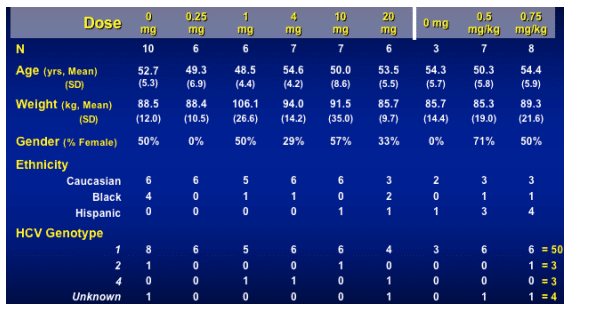
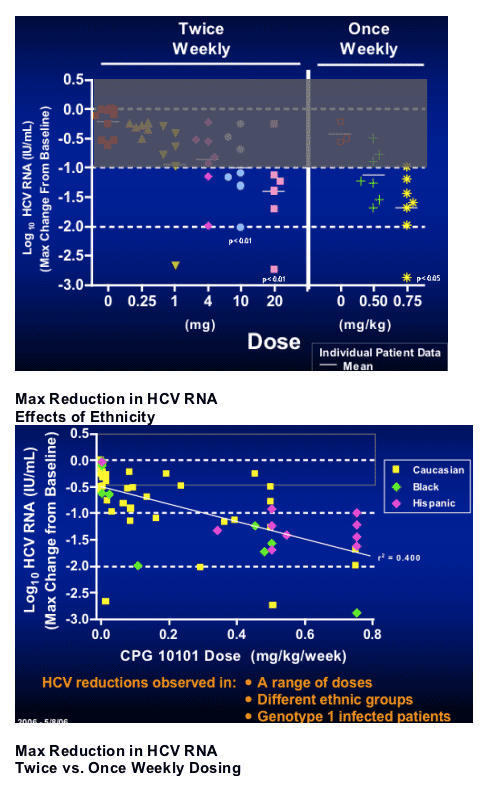

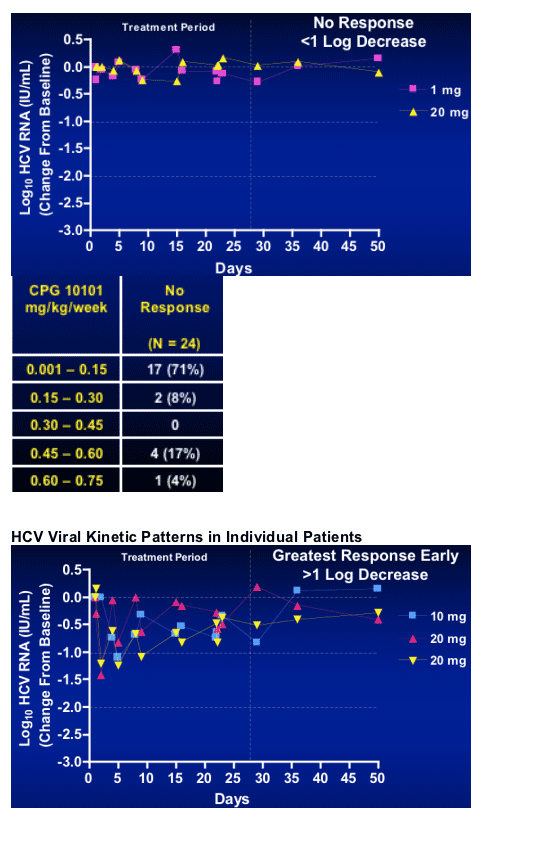
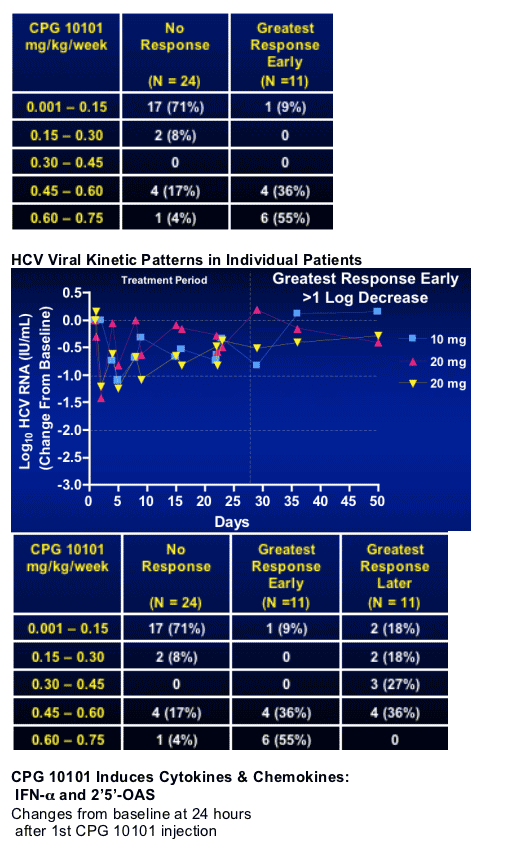

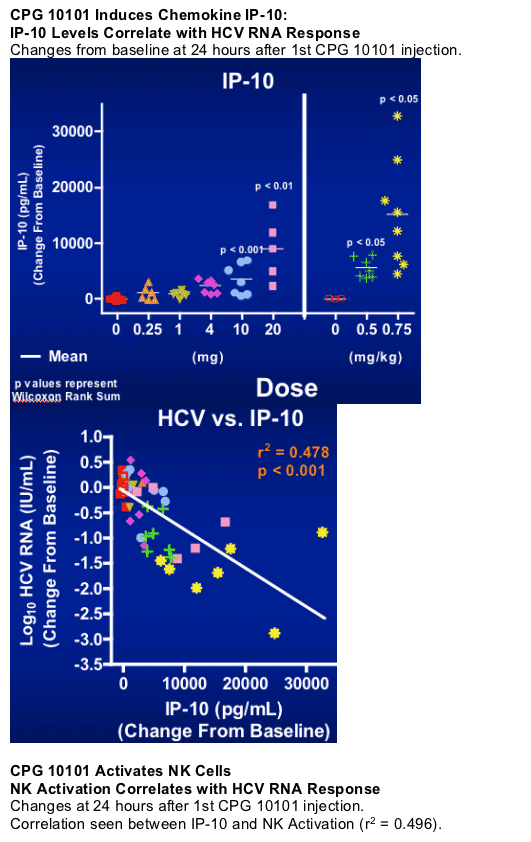
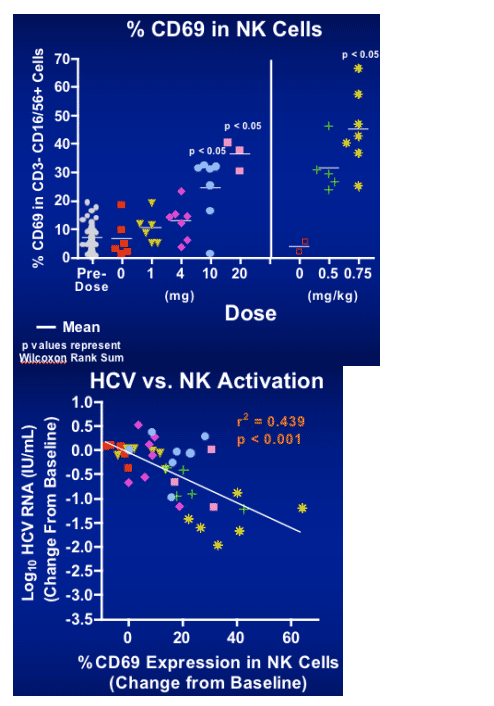
HCV RNA Responses, Pharmacodynamics & Cellular Activation
- Dose-dependent effect on HCV RNA levels
- Increase in PD markers & cellular activation
- PD markers: IFN-_, IP-10, 2'5'-OAS
- Activation: NK, T, pDC, NKT, B
Increases underlie HCV viral level changes
Once or twice weekly dosing induce similar changes at comparable doses.
Safety & Tolerability
- CPG 10101 generally well tolerated
- AE profile consistent with immunomodulatory MoA
- Injection site reactions, flu-like symptoms, headache, nausea
- Full dose escalation completed
- Number of AEs not dose-dependent
- AEs predominantly Grade 1 & 2
- No Grade 4 AEs
- Withdrawals
- 2 related to flu-like symptoms
- Related DLTs (Grade 3 for >7 days)
- 2 flu-like symptoms
- 1 neutropenia
- 1 treatment-related SAE
- Urticarial rash with pruritus after 8 doses (10 mg)
- No evidence of ALT flares
Intensity of Adverse Events
Number of AEs not dose-dependent
Green=grade 1
Yellow=grade 2
Orange=grade 3
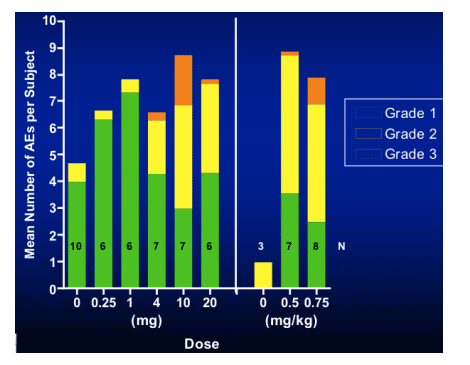
Future Steps
Randomized, controlled Phase 1b study in genotype 1 Treatment-Refractory patients (RRs)
- CPG 10101 improves antiviral activity of PEG-IFN + RBV
Greater RVR, EVR, & HCV Undetectable responses in CPG + PEG-IFN + RBV group than PEG-IFN + RBV group
- CPG 10101 synergistic with PEG-IFN + RBV
Randomized, controlled Phase 2 study in genotype 1 Treatment-Refractory NRs
- 90 patients (1:1:1)
1. 0.2 mg/kg CPG 10101 + PEG-IFN + RBV
2. 0.5 mg/kg CPG 10101 + PEG-IFN + RBV
3. PEG-IFN + RBV
- Currently enrolling
Future international trials planned in Treatment-Refractory patients
|
| |
|
 |
 |
|
|